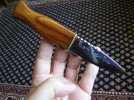- Joined
- May 27, 2014
- Messages
- 106
I put a TRU oil finish on the handles of my WWII and Gelbu Special. The first attempt, after a week of drying, which is normally dry to the touch after a day, simply left a waxy coating on the wood. It was not sticky at all, which TRU oil is when it's trying to dry. It simply felt as though I'd rubbed it down with parafin wax. I used steel wool on it and put on another coat.
After a week, parts of the finish were dry to the touch while other sections were still sticky. So, more steel wool and another coat. This time, (third application) the finish took on the entire handle. I was able to put three or four more coats and the result is beautiful. (I don't know how to post pictures or I would as I'm rather proud of the result.)
The karda and chakma for both khukuri, however, are another story. The karda for my Gelbu special turned out great after three applications (just like the khukuri handles), but, both chakma and the karda for the WWII just will not dry.
Prior sanding before the first coat, and a coat of Tru Oil once a week for four weeks, and it still will not dry with a week between each attempt.
Is there something in this wood (I believe it's satisal) that hinders the oil finish from taking?
After a week, parts of the finish were dry to the touch while other sections were still sticky. So, more steel wool and another coat. This time, (third application) the finish took on the entire handle. I was able to put three or four more coats and the result is beautiful. (I don't know how to post pictures or I would as I'm rather proud of the result.)
The karda and chakma for both khukuri, however, are another story. The karda for my Gelbu special turned out great after three applications (just like the khukuri handles), but, both chakma and the karda for the WWII just will not dry.
Prior sanding before the first coat, and a coat of Tru Oil once a week for four weeks, and it still will not dry with a week between each attempt.
Is there something in this wood (I believe it's satisal) that hinders the oil finish from taking?



